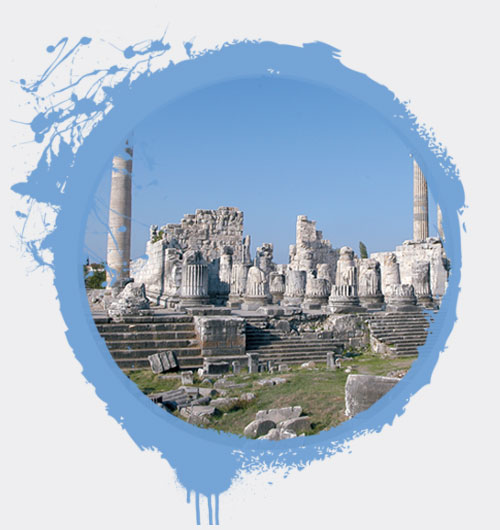
Miletos
The first thing coming to mind when "Miletus" is mentioned is the big city which became prominent with the governors of Aegean Sea, being the birth place of and science and philosophy, and its navigation in Archaic Period. The ruins attracting the attention belong to Roman Period. Definitely, Miletus was a big city in Roman Period as well, but it does not content the visitors, for instance as the same as Ephesus does. This feeling increases with the effect of the natural environment which alters wholly because of the alluvion carried by Maiandros River. Herodotus ascribed "striving river" to the ones like Maiandros. Indeed, Menderes causes the shore to move by 6-10 m. averagely in a year since before now. Located on a headland on the shore of a big gulf in Classical Period, Miletus stayed inside the land from the sea by 8 km now. Lade Island which acquired a bad reputation seems like a barren hill rising in the middle of the plain today. Gulf of Latmos turned into Bafa Lake. When you stand on the hill above the theatre, you should stretch your imagination thoroughly to understand how Miletus seemed once upon a time.
Miletus has the precedence of being the unique city among the cities of Ionia as Homeros mentioned. From the standpoint of the poet, Miletus is "the country of Carians who spoke a profane language" and fought against Greek in Troia.
Fortifications of Miletus evidenced the insecure environment of West Anatolia during that period. It is mentioned that one of the sons of Codros, Neilus governed the following Ion colonists. When the colonists arrived there, they met with the native Carians and a Cretan community who migrated from a town having the same name in Cretan. As told by Herodotus, Ions who never brought women along killed the men of the city and married their widowed wives. Upon this incident, the women vowed not to sit down to meal with their husbands and not to call their husbands’ names.
Crowning achievements in the field of thought accompanied the prosperity in the material field. First of all, the name of Thales should be mentioned. It was stated above that he characterized the water as the parent material in universe and he calculated the eclipse of the sun previously in 585 BC. It is also told that Thales changed Halys River bad to enable Croesus armies to pass.
We learnt that Thales is the first person who achieved drawing a right triangle inside a circle. He sacrificed a cattle to celebrate this, namely he feasted well. Another achievement of the philosopher is calculating the height of the Egyptian pyramids. He did this by measuring the shadows of the pyramids when a human’s shadow equaled his real height. The most recognized phrase of Thales gives the message "Know yourself" and was scraped onto Temple of Apollo in Delphoi. In another phrase of Thales which perhaps seems contrarian for the human of our age, he stated that he was grateful to gods for three blessings: he was born a human being and not one of the brutes; he was born a man and not a woman; he was born a Greek and not a barbarian.
The last excavations lightened the earliest settlement in Miletus partly, in other words the settlement of pre-Greek period. It was understood that this settlement was located on the plain in southwest of the common ruin and dated back to around 1600 BC, namely Minos and Myken Period. The power of Minos disappeared in the 14th century BC and the settlement in Miletus was surrounded by a massive wall with a thickness exceeding 4.27 m.
As understood from the clear fire marks detected in the excavations, the life in Miletus continued during pre-Greek period until it was destroyed by Persians in 494 BC. However, whether Miletus is the city where Thales and Hekataios lived or not is not known for now, because any extensive clarification was not attempted. Kalabak Hill was excavated between 1904 and 1908 and in addition to tough walls with 3.66 m thickness and doors, the ruins of houses’ various bases and a small temple were brought to light.